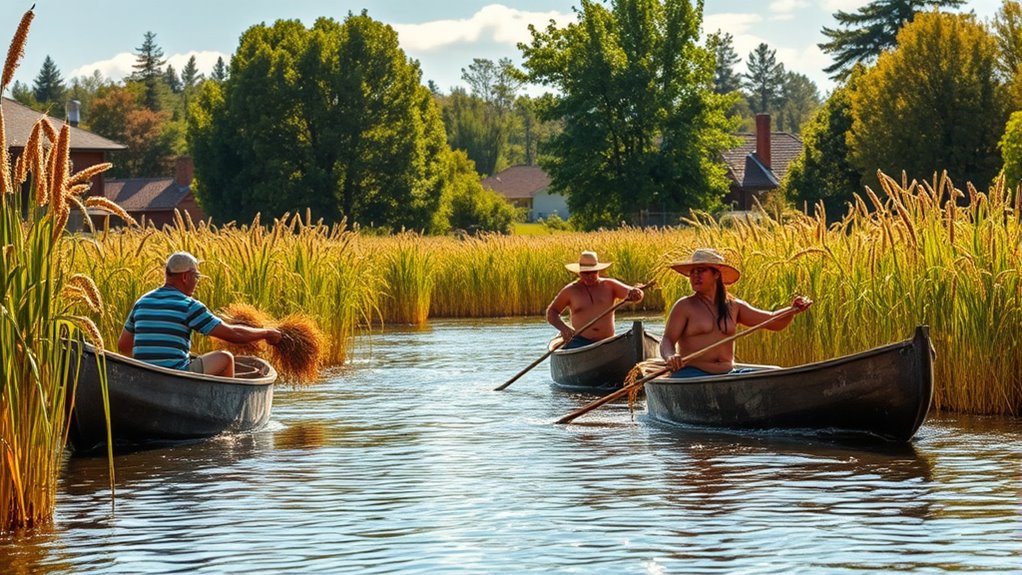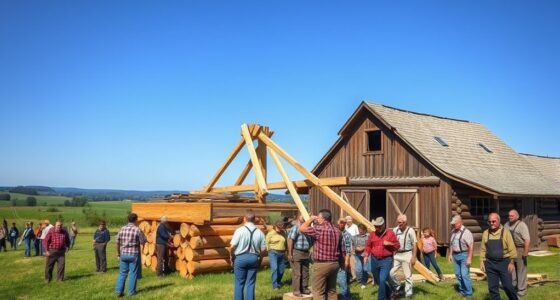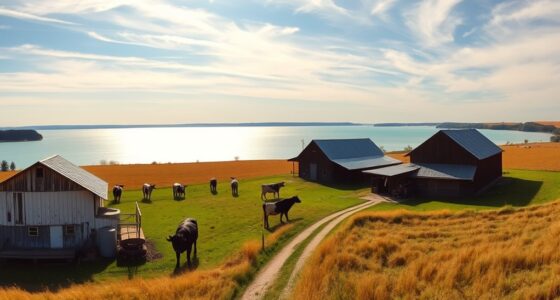If you visit Ojibwe communities near rural settlements during wild rice harvest season, you’ll see how they balance tradition with ecological care. They harvest manoomin carefully by hand, respecting natural cycles and conserving the environment. Their practices include community rituals, sustainable tools, and selective gathering to ensure future abundance. These methods reflect a deep connection between cultural values and ecological health, offering a meaningful example of respectful harvest. Continue to explore how these traditions support both culture and nature.
Key Takeaways
- Ojibwe communities harvest wild rice, or manoomin, in nearby wetlands during late summer, emphasizing cultural rituals and traditional practices.
- Harvesting is carefully managed through hand-picking and selective gathering to protect ecological health near rural settlements.
- Sustainable methods, including minimal ecological impact tools, ensure wild rice populations remain abundant for future harvests.
- The process fosters community gatherings with stories, songs, and prayers, reinforcing cultural identity and spiritual connection to land.
- Ecological stewardship principles are integrated into harvesting, supporting water quality, biodiversity, and the health of surrounding wetlands.

Have you ever wondered how the Ojibwe people harvest their sacred wild rice? This ancient practice isn’t just about gathering food; it’s a deep-rooted tradition that holds profound cultural significance. For the Ojibwe, wild rice—called “manoomin”—is more than a staple; it symbolizes life, community, and spiritual connection to the land and water. The harvest typically takes place in late summer, when the rice is ripe and ready to be gathered. As you observe, you’ll notice that the process is carefully managed to honor the environment and uphold cultural values. The Ojibwe have developed sustainable methods that ensure the rice continues to thrive for generations to come, emphasizing a harmonious relationship with nature rather than exploiting it. This respectful approach underscores their cultural significance, demonstrating their understanding that the health of the wild rice directly reflects the health of their community and ecosystems.
When you see the harvest in action, you’ll realize that it’s a delicate balance that impacts the ecological health of the surrounding environment. The Ojibwe’s traditional practices, such as hand-harvesting and selective gathering, minimize ecological impact. They avoid overharvesting, which can damage the delicate aquatic habitats where wild rice grows. Instead, they focus on harvesting only mature stalks, leaving enough behind to ensure regrowth and sustain the wetland ecosystems. This thoughtful approach helps maintain water quality, supports local wildlife, and preserves biodiversity. By respecting the natural cycles and limiting their impact, the Ojibwe demonstrate a deep understanding of ecological principles that sustain the environment and, ultimately, their cultural practices.
In addition, the use of sustainable solar-powered tools and environmentally conscious methods further exemplifies their commitment to ecological preservation. As you watch a harvest, it becomes clear that this isn’t merely an act of gathering food but a sacred ritual rooted in centuries of tradition. The community often gathers together, sharing stories, songs, and prayers that reinforce their spiritual connection to the rice and the land. This collective effort not only sustains their physical needs but also reinforces their cultural identity and spiritual values. The ecological impact of their methods ensures that wild rice remains abundant and healthy, allowing future generations to continue this important tradition. Their careful stewardship reminds us of the importance of respecting nature’s rhythms and recognizing that sustainable practices can support both cultural heritage and ecological health. In this way, the Ojibwe’s wild rice harvest is a powerful example of how cultural significance and ecological impact can coexist harmoniously, inspiring us all to honor and protect our natural resources.
Frequently Asked Questions
How Do Ojibwe Communities Ensure Sustainable Wild Rice Harvesting?
You can see that Ojibwe communities guarantee sustainable wild rice harvesting by practicing wild rice conservation and relying on traditional ecological knowledge. They carefully monitor rice beds, harvest only what’s needed, and avoid overharvesting. By respecting natural cycles and understanding ecological indicators, they maintain healthy rice populations for future generations. This respectful approach balances cultural traditions with environmental stewardship, securing wild rice remains a crucial resource for their community.
What Cultural Traditions Are Associated With Wild Rice Harvests?
During wild rice harvests, you partake in powerful practices like traditional music and ceremonial dances that preserve cultural pride. These traditions teach respect for nature, foster community connections, and honor ancestors’ teachings. As you sing soulful songs and perform sacred dances, you celebrate the harvest’s significance, reinforcing spiritual bonds and cultural identity. These rituals remind you of the deep connection between the people, the land, and the sacred rice, strengthening your shared heritage.
Are There Specific Tools Used During the Wild Rice Gathering Process?
You use traditional tools like a wooden rake, known as a “mino-bag,” and a canoe for gathering wild rice. Harvesting equipment often includes a long wooden stick to shake the rice stalks and a basket to collect the grains. These tools help you efficiently gather rice while respecting cultural practices. By using these traditional tools, you preserve the heritage and guarantee a sustainable harvest for future generations.
How Has Wild Rice Harvesting Impacted Local Ecosystems Over Time?
You might notice that wild rice harvesting has both positive and negative impacts on local ecosystems. It can support wild rice biodiversity by encouraging traditional harvesting methods, but overharvesting or modern techniques may harm aquatic ecosystem health. As you participate or observe, remember that sustainable practices help maintain the balance, ensuring this essential resource continues to thrive without disrupting the aquatic environment or reducing biodiversity over time.
What Challenges Do Harvesters Face During the Wild Rice Season?
During wild rice season, you face challenges like unpredictable weather caused by climate change, which can shorten harvest windows or damage crops. Invasive species threaten native rice beds, making it harder to harvest healthy plants and risking ecosystem balance. You also deal with fluctuating water levels and potential pollution, all of which complicate your harvest efforts and require adaptive strategies to protect this essential resource.
Conclusion
As you witness the Ojibwe wild rice harvests near rural settlements, remember it’s more than just gathering grains—it’s a dance with nature’s rhythm, a tradition woven into the land itself. These harvests are like the heartbeat of a culture that sustains and connects generations. Protecting this sacred harvest guarantees that the song of the Ojibwe spirit continues to echo through time, a reminder that some treasures are best preserved like delicate threads in a woven tapestry.










